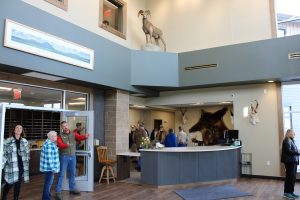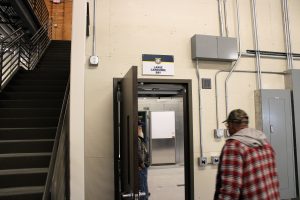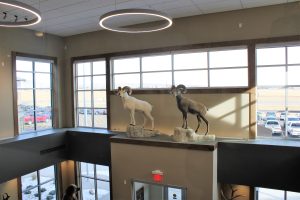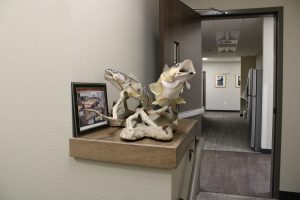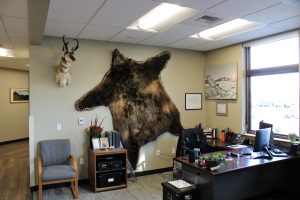New Cody Regional Office for Wyoming Game and Fish Is Complete
Written by Caleb Nelson on November 16, 2022
Wyoming Game and Fish Department held an open house this morning to commemorate the completion of their new Cody Regional Office. The event was well attended as folks came out to hear brief remarks about the project from Regional Wildlife Supervisor Dan Smith, Director of Wyoming Game and Fish Brian Nesvik, Commissioner Ashlee Lundvall, and Commission President Kenneth Roberts.
Describing the old Game and Fish office back in the early 2000s, Smith humorously says, “There was this little break room, lunchroom thing…and they said, this is your office. And then within a week, they put a wall up right down the middle of it to cut that break room in half…and so for the next year, I was the most hated person in the region because everyone lost their break room.”
Twenty years later, Game and Fish finally have their new regional office completed. The structure is open, bright, and spacious with subtle accents of sportsmen décor.
Importantly, the cost of the building did not come out of taxpayer money in the general fund – it was instead funded by the sportsmen and sportswomen of Wyoming.
Wyoming Game and Fish in Cheyenne, Laramie, and Sheridan, all built new offices before Cody had the chance to do the same.
“Everybody else but us got a new office,” Smith says. “We finally hit this milestone and we wanted to share that with the public.”
“I sure appreciate everybody coming out here today to celebrate what I think is a pretty neat achievement for the Bighorn Basin,” says Nesvik
The original Game and Fish office was built in 1979, Nesivk says. “It was intended for 9 to 14 employees maximum, and it was situated on six acres – as most of you know,” Nesvik adds.
Issues with the limited size of the previous building caused a variety of problems, Nesvik explains. “Members of the public, they were always in a hurry to get out because it was crowded at the front counter – you could only have about four or five people and it was pretty darn cozy,” Nesvik states.
Public meetings often had to be moved from the basement of the old Game and Fish office due to a lack of space. Temperature regulation in the old office had been an issue as well as safety concerns when people pulled in with horse trailers and boat trailers because of the inadequate room for vehicle traffic.
Game and Fish now deals with certain outdoor conservation challenges like aquatic invasive species and large carnivores in a more significant way, which also highlighted the need for a modern workspace for employees and staff.
“As all of you that live here can attest to, grizzly bears and wolves in 1979, the challenges we face today were not there at that time. Over time we grew, and for good reason,” Nesvik says.
Different designs for the new building were being reviewed all the way back in 2010. “We had a great opportunity here when we found this property. We explored a lot of different options,” Nesivk says.
Game and Fish considered buying existing properties and rebuilding on the old site before settling on the current location, 2 Tiden Trail in Cody. The Game and Fish Commission, as part of its fifty-year vision, wanted to own the building and the land.
The Cody Regional Office now has 26 full-time employees as well as temporary and seasonal employees throughout the year.
Commission President Roberts, after thanking several people for their efforts on the project, says, “This building cost $9.6 million dollars. We stayed within budget, no state general funds were used for this building…we don’t owe anything on this building, this is your building now – this is the state’s building.”
This “capital construction project” will allow Game and Fish to be more responsive to the needs of wildlife and the needs of the community, Nesivk says. The design of the entire property takes into consideration things like the ability to bring boats in for inspection or decontamination, and ease of access for horse trailers as well as better capability to receive bear, lion, and gray wolf harvests, etc.
“The Bighorn Basin is known to be across the state a wildlife mecca – it’s one of our treasures in this state,” Nesvik says.

